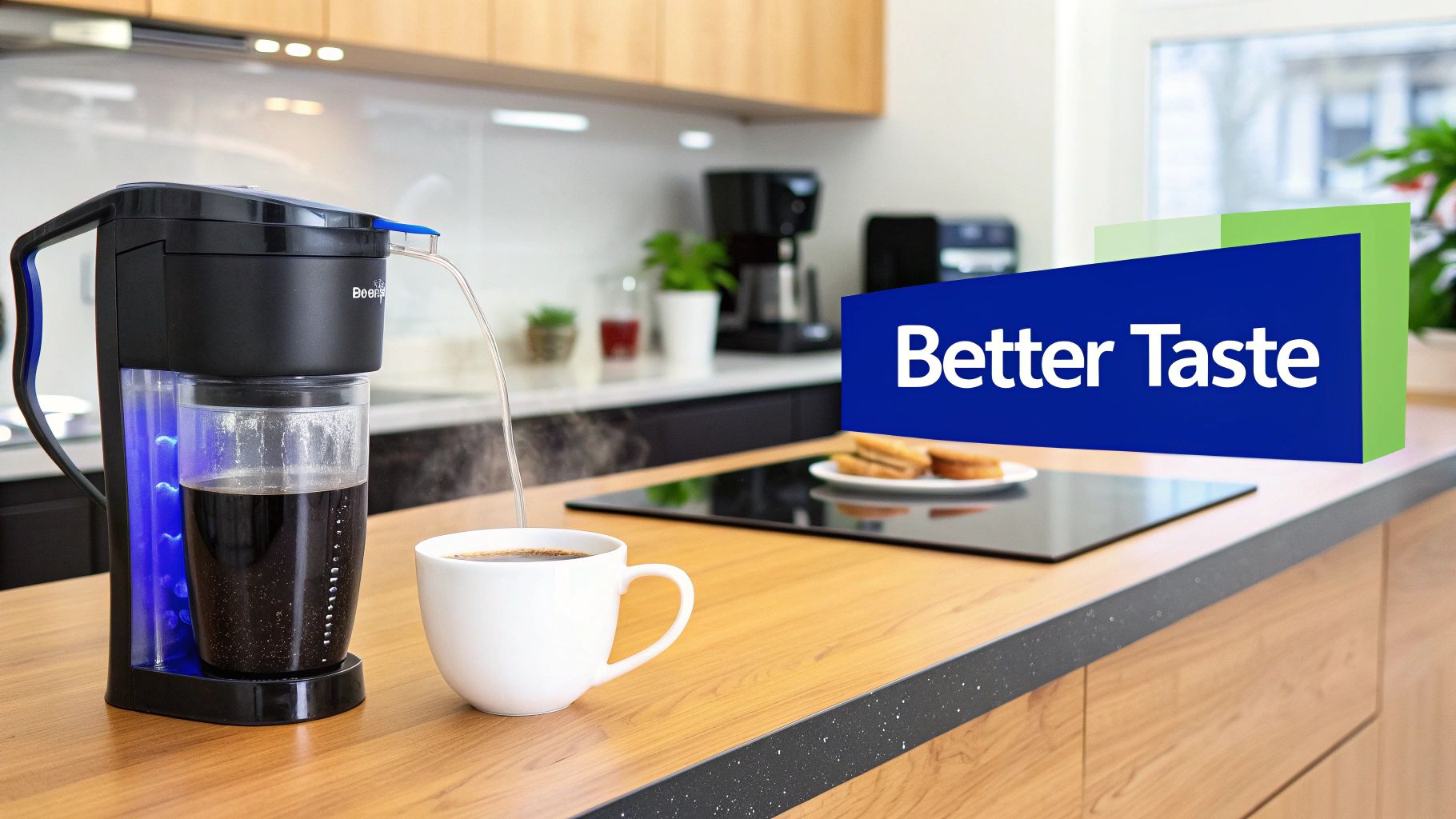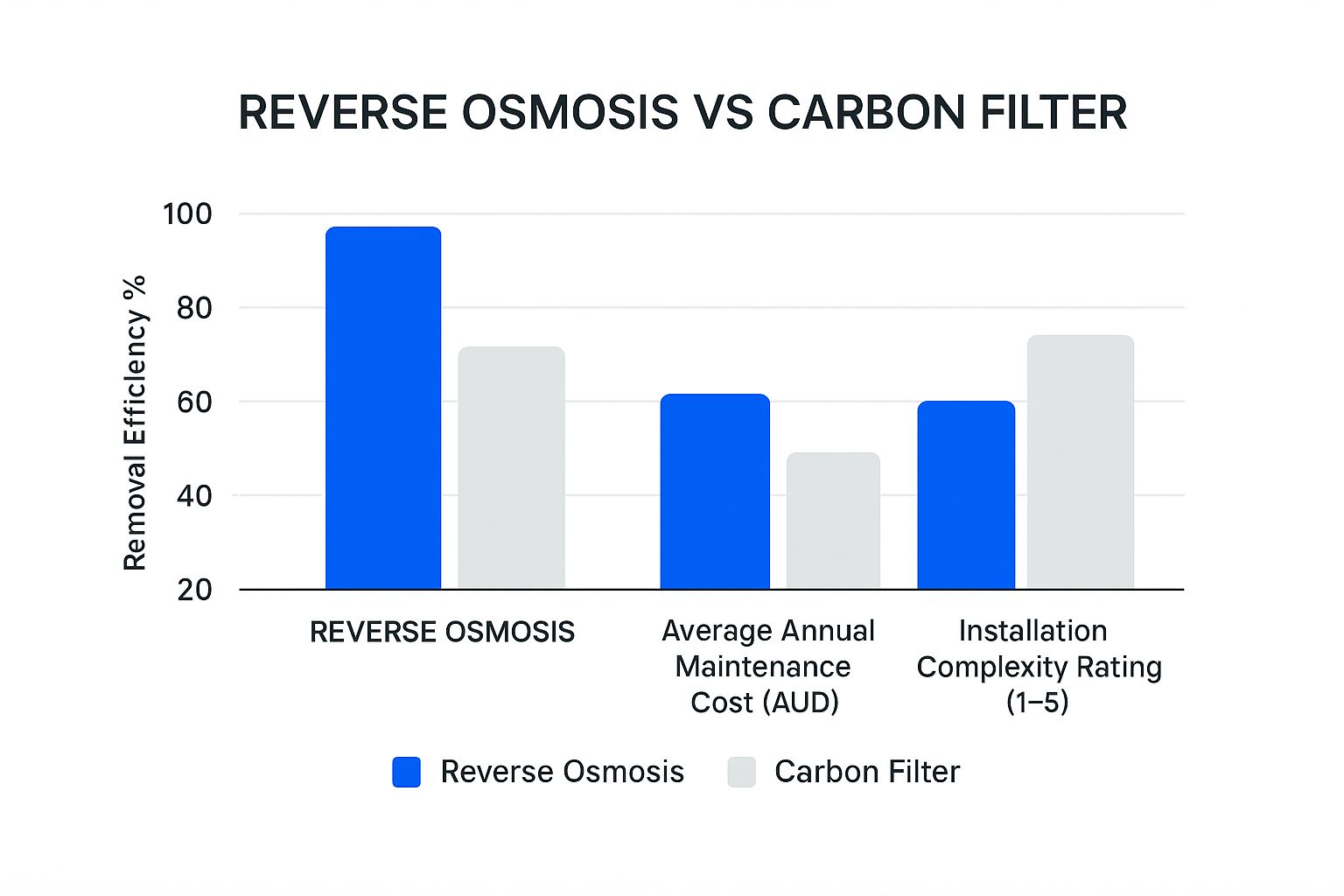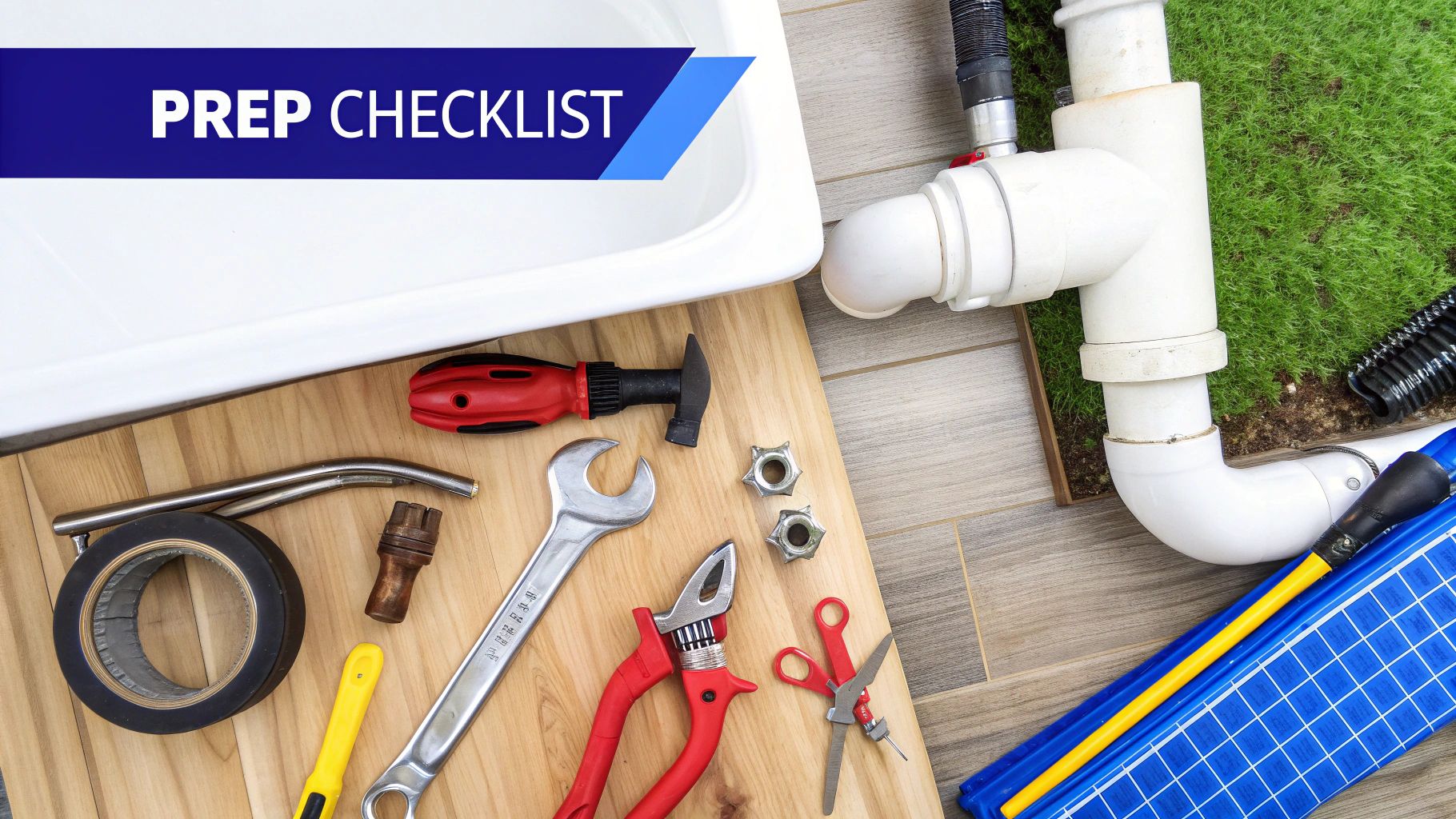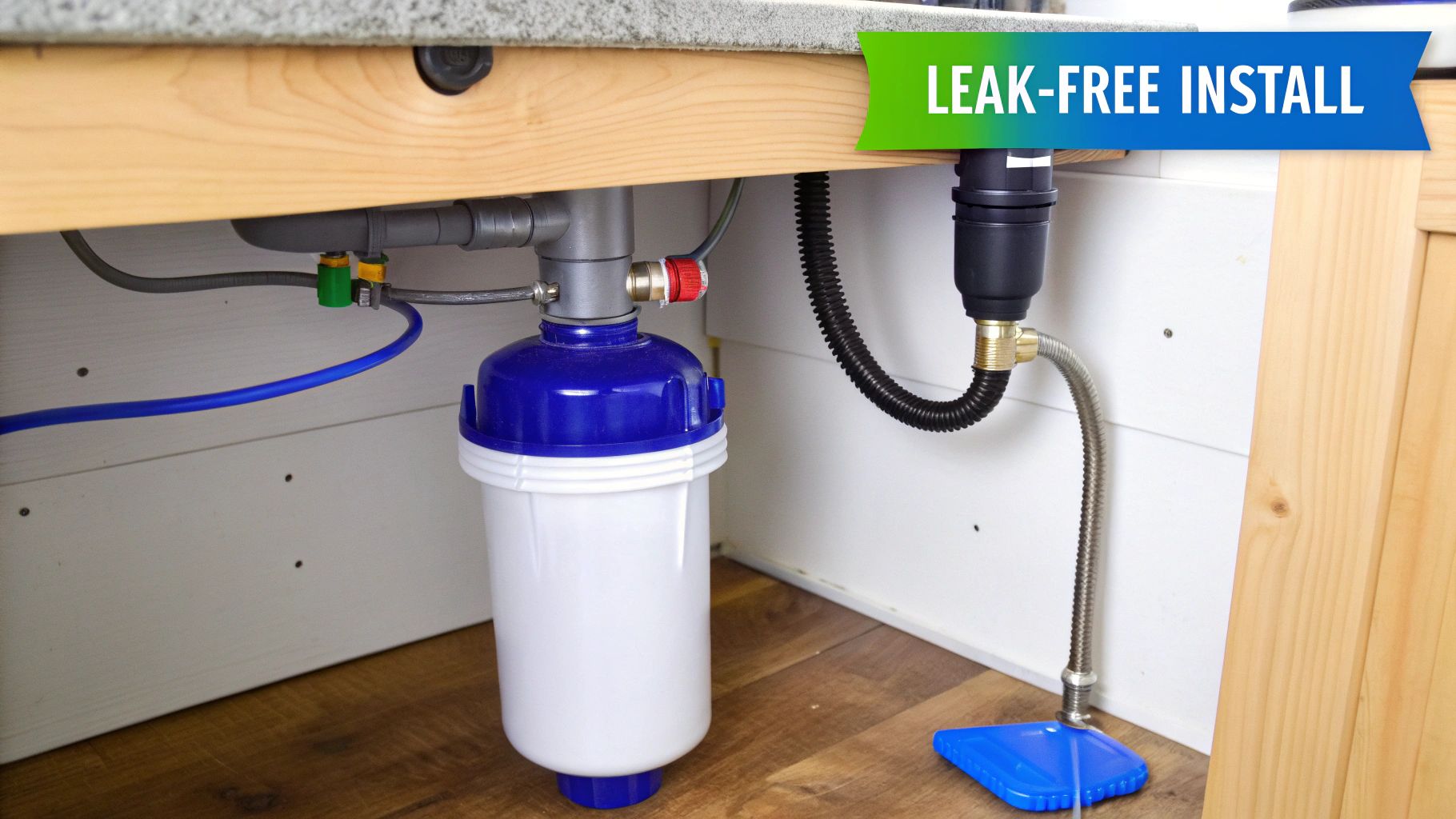While a professional water filter installation in Sydney is always a great way to guarantee performance, I've found that for most homeowners, the decision goes way beyond just water quality. It's really about elevating daily life, cutting down on waste, and buying a bit of extra peace of mind.
Why Sydney Homeowners Install Water Filters

Let’s be honest, Sydney’s tap water is perfectly safe to drink. So why are so many people fitting their homes with filtration systems? It's not usually about fixing a major problem. It’s more of a lifestyle upgrade—a smart investment in better health, convenience, and taste.
This isn't just a hunch; it's a huge trend. The Australian water purifier market hit AUD 316.28 million in 2024 and is climbing fast. People are more aware of potential contaminants and the reality of our ageing city pipes.
Elevating Your Daily Routine
One of the first things people tell me is they just want better-tasting water. A good filter can completely change the flavour of your morning coffee or that pot of tea in the afternoon. It pulls out that faint chlorine taste from the municipal treatment, and the difference is immediate.
This is a big one for families, especially with kids who can be fussy about odd tastes or smells in their water. The end goal is simple: pure, crisp water, right from the tap.
Moving Beyond Plastic Bottles
The push to reduce household waste is another massive driver. Kicking the single-use plastic bottle habit is a big win for the environment, and having a filter at home makes it almost effortless. Not only does this cut down on plastic clogging up our environment, but it also genuinely saves you money over time.
Filtering your water at the source gives you a limitless supply of pristine drinking water. You get all the quality without the constant cost and environmental toll of bottled water. It’s a small change with a surprisingly big impact.
Gaining Control Over Water Quality
Even though Sydney's water meets national safety standards, a lot of us just want that extra layer of security. A filter puts you in the driver's seat, letting you decide what your family consumes.
- Chlorine and Sediment: Most filters are brilliant at removing that swimming-pool taste of chlorine and any fine sediment that might have travelled through the pipes.
- Trace Contaminants: More sophisticated systems are designed to reduce things like heavy metals, pesticides, and other trace nasties that can sometimes find their way into the water supply.
- Peace of Mind: Honestly, just knowing your water is getting one final clean right before you drink it is priceless. If you want to get specific, you can even learn how to test water for bacteria to see what’s really going on.
At the end of the day, installing a water filter is a proactive step towards a healthier home. If you're curious about all the advantages, have a look at our guide on the 10 reasons to filter your tap water.
Choosing The Right Filter For Your Sydney Home
Picking the right water filter can feel like a massive task. The market is flooded with options, each promising the purest water imaginable, but what actually works for a typical Sydney lifestyle? It really comes down to matching the tech to your home, whether you're in a compact CBD apartment or a sprawling family house in the suburbs.
The first big question to ask yourself is: what am I trying to achieve? Are you mostly just trying to improve the taste by getting rid of that swimming-pool chlorine smell? Or are you more concerned about things like heavy metals, fluoride, or other trace contaminants? Your answer here is what will point you toward the right kind of filter.
Under-Sink vs Whole-House Systems
For a lot of Sydneysiders, especially those in apartments, townhouses, or even just smaller homes, an under-sink filter is the perfect fit. These units are compact, tucking away neatly out of sight and feeding filtered water to a dedicated tap right at your kitchen sink. They're brilliant for targeting the water you use most for drinking and cooking.
On the flip side, if you own a larger home, you might want to think bigger with a whole-house system. These are installed right where your main water line enters the property. This means every tap—from the kitchen to the bathroom showers and even the laundry—delivers filtered water. If you're after a complete solution for your property, it's worth exploring the different whole house water filtration systems available to find the best match.
Carbon Filters vs Reverse Osmosis
The two most common technologies you'll come across are activated carbon filters and reverse osmosis (RO) systems. They work in completely different ways and each has its own clear benefits.
- Activated Carbon Filters: These are fantastic for making your water taste and smell better. They use incredibly porous carbon to absorb impurities like chlorine and various organic compounds. They're generally more affordable and the installation is pretty straightforward.
- Reverse Osmosis (RO) Systems: An RO system offers a much more intensive level of filtration. It pushes water through a special semi-permeable membrane to strip out a huge range of contaminants, including salts, fluoride, heavy metals, and even microscopic nasties. The trade-off? The installation is usually more involved, and the ongoing maintenance is a bit higher.
Honestly, choosing the right filter is a balancing act. It’s about weighing the initial cost and installation effort against the level of filtration your family truly needs for peace of mind.
Comparing Water Filter Systems for Sydney Homes
To make things a bit clearer, here's a quick comparison of the most common filter types and how they stack up for different Sydney households.
| Filter Type | Average Cost (System + Install) | Best For Removing | Ideal Sydney Scenario |
|---|---|---|---|
| Activated Carbon | $250 - $600 | Chlorine, bad taste/odour, sediment, some chemicals | An apartment in Parramatta or a townhouse in Manly where the main goal is better-tasting drinking and cooking water without a complex setup. |
| Reverse Osmosis | $500 - $1,500+ | Fluoride, heavy metals (lead, arsenic), salts, bacteria, viruses | A family home in the Hills District concerned about specific contaminants reported in the area or wanting the highest level of purification. |
| Whole-House | $1,500 - $5,000+ | Chlorine, sediment, and specific contaminants (depending on filter stages) | A larger house in the Sutherland Shire where the owners want filtered water for showers and appliances to reduce scale buildup and chlorine exposure. |
This table should give you a good starting point. Carbon filters are often the perfect all-rounder for most, while RO and whole-house systems are for those who need or want that next level of filtration.
To help you decide, this chart breaks down the two most popular under-sink options—reverse osmosis and carbon filters—side by side.

As you can see, reverse osmosis gives you superior contaminant removal but comes with higher maintenance costs and a more involved setup. Carbon filters, however, strike an excellent balance between performance and affordability for most households.
For a deeper dive, check out our complete guide on choosing the right water filtration system for your home or business. It will help you nail down a choice that fits your specific needs and budget perfectly.
Preparing For Your Water Filter Installation

A successful water filter installation in Sydney doesn't start with cutting the water supply. It begins long before that, with a bit of smart preparation. Taking a few moments to size up your space and get the right gear ready will save you from those frustrating mid-job dashes to Bunnings and ensure everything goes smoothly.
Think of this as your pre-flight checklist. Whether you're squeezing under the kitchen sink or setting up a larger system, getting this part right is the difference between a quick job and a weekend-long headache.
Assessing Your Under-Sink Space
First things first: get a clear view of where your new filter is going to live. Empty out that under-sink cupboard completely. You need a clean, well-lit workspace, and trust me, you'll want more elbow room than you think.
Now, have a good look at your existing plumbing. Most modern Sydney homes use flexible braided hoses to connect to the mains, which makes life a lot easier. If you’re staring at old, rigid copper pipes, the job just got more complicated. You might need special fittings or even a hand from a professional.
Get the measuring tape out. Check the height, width, and depth to make sure your chosen filter unit will fit comfortably without crimping hoses or blocking access to important bits like your P-trap.
Gathering The Essential Tools
Having your tools ready to go is non-negotiable. There's nothing worse than scrambling for a wrench while your home's water is turned off. Lay everything out before you even think about touching a valve.
Here’s a quick list of the absolute must-haves for a standard under-sink job:
- An adjustable wrench is your best friend for tightening and loosening nuts.
- A bucket and a few old towels are essential. No matter how careful you are, there will be some drips.
- A sharp utility knife or a proper tube cutter for making clean, straight cuts on the filter’s plastic tubing. Messy cuts are a leading cause of leaks.
- A power drill with the right bit if you need to mount the filter unit or drill a hole for a new filter tap.
A rookie error I see all the time is overtightening plastic fittings. They just need to be snug enough to seal. Cranking down too hard can crack the plastic, leading to a slow, annoying leak. My rule is hand-tight first, then just a gentle quarter-turn with the wrench.
Special Considerations For Sydney Apartments
Living in an apartment or a property managed by a strata committee? There's an extra step you absolutely cannot skip. Before you drill a single hole or touch the plumbing, you must check your building’s bylaws.
Many strata agreements have strict rules about plumbing alterations. This is to prevent issues that could flood or impact other units, like major leaks or changes in water pressure.
A quick call or email to your strata manager will tell you what’s allowed. Getting that thumbs-up beforehand is crucial for avoiding a dispute or a fine down the line. It's a simple check that ensures your water filter installation is compliant and completely worry-free.
Your Guide To Installing An Under-Sink Filter

Alright, time to get your hands dirty. Installing an under-sink filter is a genuinely satisfying weekend project. Don't think of this as a dry, technical manual—this is our real-world walkthrough for getting the most common type of filter set up in your Sydney home. We'll give you the practical tips that make the whole process smoother.
First things first, before you even think about grabbing a wrench, you need to shut off the water. Find the small shut-off valve under your sink, which is almost always on the cold water pipe. Give it a solid quarter-turn. Then, open the kitchen tap to let any leftover water drain out. Trust me, this little step is your best friend in preventing a mini-flood.
Connecting To The Water Line
With the water safely off, you can get into the plumbing. The goal here is to fit a T-valve (it should be in your kit) onto the cold water line. This nifty component is what lets you split the water flow—one stream to your regular tap and another to your new filter.
Simply unscrew the flexible hose from the main shut-off valve and screw the T-valve on in its place. The hose then connects right back onto the top of the T-valve. Here’s a common pitfall: don't go overboard tightening the connections. They just need to be snug. If you crank down on them with all your might, you risk stripping the threads and creating a tiny, annoying leak that will drive you crazy later.
Pro Tip: Grab some plumber's tape and wrap it a few times clockwise around the male threads before you connect everything. This helps create a perfect, watertight seal without needing brute force.
Mounting The Filter And Tap
Next, you need to decide on a home for the filter unit and its dedicated tap. The filter cartridge housing usually gets mounted with a couple of screws to the inside wall of your cupboard. Just make sure you leave yourself enough room to unscrew the housing and swap out the cartridges down the track.
Then, find a spot for the new filter tap. Many sinks in Sydney homes have a pre-drilled hole that’s just covered with a little cap—this is the jackpot! If not, you'll have to carefully drill one. Once you have the hole, you can feed the tap through and tighten it from underneath. This part can be a bit fiddly, but patience is key.
Final Connections And System Flush
You're on the home stretch. Now it's all about connecting the plastic tubing. You'll run one tube from that T-valve over to the filter's "inlet" port. Another tube runs from the "outlet" port up to the base of your new filter tap. Use a sharp utility knife for this—you want clean, square cuts. Angled or jagged cuts are the number one reason these connections leak.
With everything hooked up, it's the moment of truth. Go back to the main shut-off valve and turn the water on slowly. Check every single connection point for drips. Take your time here; a small weep can take a minute to show up.
Finally, you have to flush the system. Turn on the new filter tap and just let it run for a good five to ten minutes. This clears out any harmless carbon dust (called "fines") from the new cartridge and gets it ready for action. And that's it! You're ready to enjoy pure, delicious water straight from your own tap.
To dive deeper into these systems, you can learn all about the benefits of under-sink filtration systems and how they work in our detailed guide.
When To Call A Professional Sydney Plumber
While installing an under-sink filter is a satisfying and totally manageable DIY project for many homeowners, there are definitely times when it pays to put the tools down. Knowing when to call in a licensed professional for a water filter installation in Sydney is all about protecting your home, keeping your warranty valid, and giving yourself some well-deserved peace of mind.
The clear line in the sand is usually drawn when you get to whole-house systems. These filters don't just connect to a single tap; they hook directly into your home’s main water line. That’s a critical piece of plumbing infrastructure.
A tiny mistake here—an incorrect cut or a joint that isn't perfectly sealed—won't just result in a small puddle. It can lead to major water damage, a drop in water pressure across your entire house, and an expensive emergency call-out.
Navigating NSW Plumbing Codes
Licensed Sydney plumbers bring more than just tools and experience to the job; they bring compliance. Any work performed on your main water line must follow the strict Plumbing Code of Australia, along with specific NSW regulations.
Getting a professional to handle the installation ensures everything is up to code, which is vital for a few big reasons:
- Home Insurance: If a non-compliant DIY install leads to a flood, your insurance company might have grounds to deny the claim. That's a risk no one wants to take.
- Product Warranty: Most manufacturers of whole-house systems are very clear: their warranty is void if the unit isn't installed by a licensed plumber.
- Property Value: Certified, professional plumbing work protects your home's value and gives future buyers confidence that the job was done right.
A professional plumber’s work is fully insured and guaranteed. This means if anything goes wrong with the installation, you’re covered. It’s a layer of security that you simply don’t get when you go it alone.
Understanding Professional Installation Costs
Hiring a professional is really an investment in getting the job done right the first time. In Sydney, you can expect the cost for a whole-house water filter installation to range from AUD 1,630 to AUD 8,400. The final figure depends on how complex your chosen system is and the current state of your home's plumbing.
Labour costs alone typically account for $300 to $900 of that total, which reflects the skill needed to safely integrate the system into your home's water supply. You can discover more insights about these installation costs to help budget for your project.
While that price tag might seem a bit steep, it covers the expertise that prevents common—and very costly—mistakes. A good plumber will ensure the water pressure is correct, install a proper bypass valve for future maintenance, and use secure fittings that are built to last for years.
If you're still weighing up your options, our article goes into more detail on why a professional plumber is preferred to install a home water filter.
Ultimately, for these bigger, more complex systems, the decision comes down to risk versus reward. The upfront cost of hiring a pro is often a drop in the ocean compared to the potential cost of a DIY job gone wrong.
Keeping Your New Water Filter System in Top Shape
Getting your new filter installed is a fantastic first step, but the job isn't quite done. To keep that pure, great-tasting water flowing for years, a little bit of ongoing care is all it takes. This isn't about getting your hands dirty with complicated maintenance; it's just a simple plan to protect your investment.
The good news is that modern water filters are built to be pretty low-maintenance. The one thing you absolutely can't skip, though, is changing the filter cartridges. Think of these as the workhorses of your system—over time, they get clogged with all the gunk they've pulled out of your water.
When to Change Your Filter Cartridges
How often you need to swap out the filters really comes down to two things: the type of system you have and how much water your household goes through. A single person living in a CBD apartment will have a very different schedule than a busy family home in the suburbs.
Here’s a rough guide for the most common systems:
- Simple Carbon Filters: These typically need a change-out every six to twelve months.
- Multi-Stage Under-Sink Filters: You might find the sediment pre-filter needs changing every six months, while the main carbon block can last up to a year.
- Reverse Osmosis Systems: These are a bit more complex. The pre-filters usually need an annual swap, but the RO membrane itself can last anywhere from two to five years.
If you notice a sudden drop in water pressure from your filter tap, that's the number one sign a cartridge is clogged and ready for a change. Don't put it off—it’s a clear signal your filter has been working hard and needs a refresh.
Troubleshooting Common Hiccups
Even the best water filter installation in Sydney can hit a minor snag now and then. Before you start to worry, know that most issues are surprisingly simple to sort out. One common problem is a slow drip from a fitting, which usually just means a connection needs a gentle quarter-turn with a wrench to snug it up.
Another question we get all the time is about cloudy water right after a new cartridge is installed. This is perfectly normal! It’s just tiny air bubbles working their way out of the system, and they’ll disappear on their own after a day or two of use. For a deeper dive, check out our guide on how to maintain a water filter to prolong its life.
It's also worth remembering the sheer scale of Sydney's water network. The Prospect Water Filtration Plant is a massive facility that supplies reliable drinking water to about 85% of the city's population. That's a huge effort! Learn more about how Sydney’s water is managed to appreciate what goes on before the water even reaches your home. Your filter's regular maintenance is just the final polish to make sure what's in your glass is the absolute best it can be.
Ready to enjoy pure, great-tasting water without the hassle? Explore the full range of filters and easy-to-manage replacement plans from Awesome Water® at https://www.awesomewater.com.

